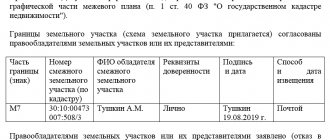When purchasing land, you need to pay attention not only to its cost, quality characteristics, and the presence of encumbrances, but also to carefully study the documents in which the boundaries of the acquired plot are established and legally fixed.
Cameraman Alisa Lawyer
Dear readers! Our articles discuss typical situations for resolving legal issues, but each problem is unique. Therefore, if you need a FREE consultation with a lawyer, call ext 946 (Moscow and Moscow region) ext 651 (St. Petersburg and Leningrad region)
If you do not check this information in a timely manner, then in the future during land surveying you will not be able to avoid disputes and conflicts with neighbors on the site, and in some cases, litigation. All this will lead to additional costs and expenses.
Regulatory regulation
In Russia, large-scale work has long been carried out to record the boundaries and land plots themselves. To achieve this, legislators introduced amendments to regulations:
- Land Code of the Russian Federation;
- Federal Law No. 218 dated July 13, 2015 “On state registration of real estate”;
- Federal Law of July 24, 2007 No. 221 “On the State Real Estate Cadastre.”
Increasingly, courts are faced with disputes regarding the boundaries of individual areas. Therefore, the obligation to prepare a boundary plan is introduced. In 2021, without it, it is impossible to register new plots of land or sell existing lands if land surveying has not been carried out previously.
Land seizure by neighbors: owner's rights
What to do if it is not possible to reach a compromise when occupying a site? The problem of land seizure by a neighbor must be solved on the basis of legislative acts of the Russian Federation. The owner can rely on the following articles:
- Art. 301 of the Civil Code of the Russian Federation, according to which the owner has the right to demand the return of his land if someone uses it illegally.
- Art. 304 of the Civil Code of the Russian Federation - the owner has the right to put forward demands to eliminate violations of his rights, even if the right of ownership has not been infringed. This means that if an obstacle is created to the use of a property, the owner can file a negatory claim (a non-contractual demand against third parties to remove obstacles to the implementation of property rights).
- Art. 208 of the Civil Code of the Russian Federation, which states that there is no limitation period for violations of this type. This means that, no matter how much time has passed, the owner can in any case go to court to protect his rights.
The reason for going to court may be not only the direct seizure of part of the territory, but also a violation by a neighbor of the established SNiP 30-102-99. For example, if the distance between your neighbor’s bathhouse and your fence is less than a meter, then this may be grounds for going to court.
In any case, it is worth starting to resolve the issue by trying to solve the problem peacefully. Neighbors may not even be aware that they have trespassed. It is possible that it will be enough to review the documents for the issue to be resolved.
If neighbors are aware of the illegality of their actions, but do not want to come to an agreement peacefully, they can file a complaint with the administration, and then with the land committee. This is necessary to document the fact of violation of the land use order.
When all possible methods of influence do not produce the desired result, it is advisable to contact the judicial authorities. The court will order an examination to prove that a violation actually occurred. Accordingly, in order to go to court, you must have a document confirming ownership of the land plot (certificate or extract from the Unified State Register of Real Estate) or the right of ownership (for example, a lease agreement with the municipality).
For the trial, you will need to collect other evidence of your innocence. For example, they may include witness statements, expert opinions, photographs or video footage.
Some experts recommend contacting the prosecutor's office rather than going to court. As a rule, this does not give the desired results. The fact is that the prosecutor’s office will not be involved in finding out “who is right and who is wrong” and ordering an examination; this is the responsibility of the judicial authorities.
Features of land surveying
To avoid a dispute about the boundaries of a land plot with neighbors, it is important to carry out land surveying in a timely and correct manner. These works make it possible to determine, secure and restore the area of the site within its boundaries. Other relevant information is also included in the documents.
Land surveying is carried out in the following cases:
- redistribution of lands in the process of their consolidation, division or creation of new objects;
- privatization of the site;
- clarification of boundaries;
- obtaining permission for construction work on building a house;
- obtaining a cadastral passport and other documentation for land;
- allocation of land from common property.
How to avoid land disputes with a neighbor? FKP advice
“Borderline” disagreements are not uncommon for owners of two adjacent plots. The Federal Cadastral Chamber named the reason for the disputes over the territory and supported the expert opinion with figures.
The Cadastral Chamber recommends that owners of land plots whose boundaries are not defined carry out land surveying and enter updated information into the Unified State Register of Real Estate (USRN). Practice shows that it is the absence of precisely defined boundaries that is the cause of most disputes between owners of adjacent plots. Clarifying the boundaries will protect the rights of owners and also minimize the occurrence of additional risks.
In the Federal Law on Cadastral Activities under an Adjacent Land Plot
refers to a plot of land, the boundaries of which are also the boundaries of another. That is, where your territory ends, your neighbor’s “hundreds” begin. Disputes may also arise if the land plots do not border each other, but their use is the only opportunity to gain access to public areas, to a water source, to carry out repair work or to meet other needs. If a similar situation arises, we recommend establishing an easement, that is, granting the right to a person or several persons to use your land plot in a limited manner. However, the establishment of an easement will not deprive you of your ownership rights. Limited use of someone else's land plot is regulated by Articles 274-277 of the Civil Code. Depending on the situation, easements are of two types: public and private. You can read more about its installation in this material.
To clarify the boundaries, it is necessary to use the services of a cadastral engineer and conduct a land survey. You can find information about current specialists in the Rosreestr service “State Register of Cadastral Engineers”. We advise you to pay attention to the experience of the cadastral engineer, the quality and timing of the procedure.
Land surveying is a voluntary measure, but its implementation will help resolve issues of the area and boundaries of the land plot, as well as avoid disputes with neighbors. After completing the cadastral work, a boundary plan and application should be submitted to the rights registration authority. This can be done remotely through the “Field Service” service. We talked in more detail about how to carry out land surveying and how much it costs.
By July 1, that is, in the first half of 2021, on the territory of the Russian Federation, the share of land plots with an updated area included in the Unified State Register of Real Estate amounted to 60.6% (36,853,079 units) with a total number of 60,860,672.
In 9 regions this figure exceeds 90%. The leaders are the republics of Bashkortostan and Tatarstan, Kaliningrad, Magadan, Sverdlovsk regions, Jewish Autonomous Region, Yamalo-Nenets Autonomous Okrug. St. Petersburg also fell into this group.
Among the outsiders in terms of the share of registered sites are the territories of the European part of Russia: the Republic of Ingushetia, the Chuvash Republic, the Kostroma and Ulyanovsk regions and the representative of the Far Eastern Federal District - the Kamchatka Territory. No more than 40% of all plots are registered here.
In Moscow and the Moscow region, the share of land plots with a specified area is 77.3% and 69.5%, respectively.
Municipalities and settlements
Land disputes, although rare, can arise not only with a neighbor in the country, but, for example, at the regional level. Entering information about the administrative-territorial division into the Unified State Register helps reduce their number. Bodies of state power and local self-government send information about the boundaries of municipalities (MUs) and settlements (NP) for inclusion in the Unified State Register of Real Estate. This norm is enshrined in paragraphs 7–8 of part 1 of article 32 of the Law on State Registration of Real Estate.
The Cadastral Chamber enters data on boundaries into the real estate register in the manner of interdepartmental information interaction. Current USRN information also helps:
- reduce the risks of doing business;
- increase the investment attractiveness of the region;
- bring unused lands into circulation;
- improve the quality of management of territories and land resources in the regions.
Here are excerpts from the statistics of data entered into the Unified State Register of Real Estate as of July 1, 2021.
Municipalities
The overall indicator of municipalities in Russia, the boundaries of which are taken into account, is favorable - 71.2%: 14,933 out of 20,984 units. The dynamics for the first half of the year are quite bright - an increase of 5.4%: in a quarter of the regions their share is more than 90%.
99–100% of the borders of the Moscow Region are included in 28 of the 85 cadastral districts of the Russian Federation, which is a third of the total number. These are the republics of Altai, Buryatia, Karelia, Mordovia, North Ossetia-Alania, Tatarstan, Khakassia, and the Chechen Republic. As well as Altai and Krasnoyarsk territories, Amur, Astrakhan, Vladimir, Voronezh, Kaliningrad, Moscow, Novosibirsk, Ryazan, Saratov, Sakhalin, Sverdlovsk, Smolensk, Tambov, Chelyabinsk, Yaroslavl regions. In addition, the real estate register takes into account 100% of the borders in the Yamalo-Nenets Autonomous Okrug (55 elements) and in two former subjects of the country: Komi-Permyak (7) and Evenki Okrug (24).
Settlements
At the end of the first half of 2021, of all settlements in Russia (155,695), only 32.3% contained information about borders in the Unified State Register of Real Estate. Since the beginning of the year, this indicator has had a continuous positive trend and by July 1st grew by 2.1%.
In addition to Moscow, where all borders are included in the Unified State Register of Real Estate, there are practically no settlements left without established borders in the Chuvash Republic and the Belgorod Region. The Krasnodar Territory and the Tyumen Region are also leaders. However, some regions cannot yet boast such high values. For example, in Kabardino-Balkaria, Mari El, Crimea, as well as the Volgograd, Kirov, Pskov, and Rostov regions, the share of NPs, information about the boundaries of which is contained in the Unified State Register of Real Estate, is less than 5%.
Border disputes
A frequent cause of conflicts between neighbors is disputes over the exact location of land boundaries. Some people do not want to give up part of their territory, but for others it becomes a matter of principle. The easiest way is to solve the problem peacefully before going to court. This makes it possible to avoid unnecessary costs and lengthy proceedings. Land disputes in Russia are considered one of the most complex. This is due to the fact that legislation in this area has not yet been fully developed. As a result, trials can last for several years.
To avoid unnecessary problems when operating the land, follow these simple recommendations:
- Check the documents provided by the cadastral engineer. Clarify unclear and controversial points in advance. At the stage of work, solving the problem is much easier and cheaper.
- If the boundaries have long been defined, it is better not to rely on old information and clarify the boundaries. To do this, you can request the boundaries to be taken out into nature, which will allow you to determine compliance with the actual location. During the process, it will be determined whether the boundaries of neighboring areas have overlapped.
Do not rush to contact the judicial and supervisory authorities for any reason. Questions may also arise regarding your land. First of all, it is important to make sure that your opinion is correct in relation to the passage of borders. And after that you can take further actions.
Judicial practice in resolving disputes
As jurisprudence on land disputes regarding land surveying shows, as well as examples on forums, many citizens do not comply with the existing territorial jurisdiction of cases and file a claim at the location of the defendant.
These actions are incorrect and claims will be returned. The claim should be filed at the location of the disputed area.
You also need to remember that controversial cases are resolved in the magistrate and district courts. In the first case, applications are considered for plots worth up to 50,000 rubles. If the cost of the claim is higher, the district court will consider it.
In judicial practice, there are often cases related to violations of the procedure for informing interested parties about the approval process. And if this order was violated, then the boundary plans may be declared invalid.
Such a decision was, for example, made by the Central District Court of Kaliningrad. The authority considered the statement of the chairman of the SNT, who claimed that he was not properly informed about the meeting to agree on the boundaries of the defendants’ land plots. The notice was published in the newspaper. The plaintiff himself was constantly on the territory of SNT and it was not difficult to notify him of the meeting, however, this was not done. Therefore, the court made the above decision.
Causes of disputes
There are standard reasons for conflicts that often lead to litigation:
- Errors in documents from which information was entered into the unified real estate register. It is possible to overlap the boundaries of plots if cadastral work on some of them was carried out relatively recently, and on others more than 10 years ago.
- Incorrect calculations by the cadastral engineer when taking measurements. In this case, it is important to prove the groundlessness by ordering a repeat survey.
- Self-capture. In this case, the neighbors move the fence without permission. This leads to an illegal reduction in the territory of neighbors. It is important to try to come to an agreement with them. If they did this intentionally and do not make contact, a trial will help. If the court's decision is positive, the borders will be restored by bailiffs.
In 2021, it has become mandatory to coordinate land surveying results with neighbors. This is done during the work of a cadastral engineer. If the rights of neighbors in this matter have not been taken into account, they can protest the results of the procedure. This is possible even if the information is entered into the state register.
Features and nuances
When preparing for trial, you need to pay special attention to the type of controversy that has arisen. Disputes about squatting or imposing boundaries are possible - in these cases the neighbor is the defendant. If we are talking, for example, about a refusal to register a plot of land, then the cadastral chamber is the defendant, and in this case the judicial process takes on its own characteristics.
Each specific case is unique and requires detailed consideration. There is practically no identical judicial practice. If possible, it is recommended to consult not only with a cadastral specialist, but also with a lawyer who will help determine the prospects of the case and potential costs.
Once a decision has been made, it must be enforced. This is where the main difficulty begins. For example, if the dispute concerned squatting, then it is necessary to ensure that the situation is returned to its original state, in accordance with the decision. A neighbor does not always voluntarily vacate the territory, even if this is indicated in the decision (for example, to move a fence at his own expense).
In this case, you must contact the bailiff service. Failure to comply with the instructions of the court and bailiffs may result in additional liability. Also, SSP employees can involve third-party organizations to dismantle an incorrectly constructed fence or other landmarks.
Controversies regarding the boundaries of land plots arise quite often. We can talk about squatting, contradictions in documents, misunderstanding of the real state of affairs. First of all, you need to try to sort out the conflict peacefully, if possible - order an independent examination, measure areas and landmarks. If it is not possible to reach an agreement, then the only option left is to go to court.
Read: How to remove obstacles to the use of land
How to resolve a border dispute?
To avoid litigation, you should try to reach an agreement with your neighbors in advance. If the issue cannot be resolved peacefully, the following algorithm of actions is applied:
- If the register contains a technical error, you must submit an application to Rosreestr to correct it. Attach documents proving the error. The registration authority must make a decision within 3 days. The error will be corrected or denied based on the correctness of the information available.
- Clarify the boundaries of your site in relation to neighboring territories. This will be the best evidence for the court. In addition, some owners may be convinced before going to trial. Invite a cadastral engineer to survey and enter into an official contract with him for the work. During the procedure, boundaries are determined, after which an approval act is drawn up. It must be signed by all neighbors interested in resolving the dispute. It is important to notify everyone about the procedure at least 7 days before it begins.
If everyone received the notice, but one of the neighbors could not be present, he can familiarize himself with the act and sign it with the cadastral engineer. In case of failure to appear, the law allows approval of the document without it.
According to Art. 43 Federal Law No. 218, if one of the neighbors refuses to agree on boundaries, the issue can only be resolved through the court. To do this, a statement of claim is drawn up and supporting documents are attached. The defendant will be the owner of the adjacent plot, who interferes with the preparation of cadastral documents.
Common causes of disagreement?
The main goal of cadastral work is to highlight the exact position of the boundaries of 2 neighboring plots. The clarification of this data should be carried out in consultation with the people who own the border land. This land could be:
- their property;
- an object of permanent use;
- rented area.
Disputes regarding boundary delineation may arise for the following reasons:
- the existing boundaries have moved or been superimposed following the actions of cadastral engineers;
- Data from engineers hired by different owners does not match;
- every landowner wants to increase his territory;
- disagreements arose when establishing land easements;
- land surveying work was carried out without the consent of neighbors;
- There are errors in the USRN information.
In addition, conflict situations often arise when dividing a plot or, conversely, annexing territories.
As already noted, an error in the Unified State Register can lead to disputes during land surveying. There are technical and register (cadastral) inaccuracies. A technical error is a letter of a word or a number. It is adjusted independently by the registrar of rights or:
- at the request of citizens interested in this case;
- according to a court verdict.
After it is corrected and the corrected data is entered into the register, the registration authority informs the parties to the relationship about this within 3 days.
A registration error in boundary or technical terms is corrected within 5 days by decision of the court or registration authority. You need to understand that correction of cadastral errors is possible, unless it leads to the emergence of a new right to real estate or to its termination.
Our lawyers are ready to provide free advice on pressing land surveying issues. You can also get the latest forms and applications from us, as well as current versions of documents - ask a lawyer.
How will the invader be punished?
Upon application, the land inspector goes to the scene of the alleged offense. He conducts an inspection and draws up a protocol. The violator is issued an order to eliminate the violation and pay a fine of 1,000 rubles.
Of course, administrative fines are small. But their presence will be the best confirmation of your rightness in court, if your neighbor does not stop violating your rights. It is important to keep records of violations. They must include the name of the offender.
What to do?
First of all, neighbors need to try to resolve the issue voluntarily. To do this, you need to raise documents about the boundaries of the plots and check the accuracy of the division of plots.
If there are no definite boundaries of the land, it is urgent to carry out land surveying. Not only the customer, but also the neighbors should participate in the procedure.
Owners of neighboring plots must agree to the definition of boundaries. If they refuse to give it voluntarily, then the customer must go to court.
By decision of the court, the boundaries of the plots will be established. On this basis, cadastral registration of the land will be carried out.
Contacting the Land Committee
The law does not give the land committee of the local administration the authority to resolve conflicts in the area of land use between owners. However, a specialist can verify the boundaries with the cadastral plan. The result of the appeal is the issuance of a decision on the presence/absence of a violation.
Algorithm of actions for obtaining a local government act
| No. | Procedure |
| 1 | Collect documents for the site |
| 2 | Submit an application to the land committee |
| 3 | Provide a specialist with access to the site |
| 4 | Get a solution |
If a violation is detected, the specialist will draw up a protocol on the administrative violation. In accordance with Art. 7.1 of the Code of Administrative Offenses of the Russian Federation, the culprit will have to pay a fine in the amount of 5,000 rubles.
The exact amount is calculated depending on the cadastral value of the captured plot and the share that was unlawfully used.
Going to court
It is also necessary to clarify whether there is an agreement to revise the boundaries between the neighbor and the former owner of the plot. This situation is called the established land use order. If there is an agreement, the court will refuse to recognize part of the land as unauthorized seizure.
If a voluntary resolution of the conflict is impossible, then it is necessary to act as follows:
- Collect information about the boundaries of the plot (cadastral passport, land survey, extract from the Unified State Register of Real Estate).
- Check the actual boundaries of the plots with the plan.
- If violations are identified, it is necessary to prepare a statement of claim in court.
- As evidence, it is necessary to provide documents on land surveying and cadastral registration of the site.
Important! One of the evidence in the process may be the result of the examination.
You can conduct research before going to court. To do this, you need to choose a specialized organization that has a license for this type of activity.
The applicant must formulate questions for the specialist, the answers to which are necessary to satisfy the requirements.
Separately, it is necessary to consider the situation when the owner of a neighboring plot has not given consent to the land survey. In this case, the court does not recognize his guilt.
When carrying out land surveying and cadastral registration, it is imperative to obtain the neighbor’s consent to the boundaries of the plots. Otherwise, the court will challenge the established framework and hold the cadastral engineer accountable.
Trial: documents
According to Art. 132 of the Code of Civil Procedure of the Russian Federation, the claim must be supported by copies of documents. The following are provided as applications:
- documents on ownership of the site;
- land survey plan;
- an extract from the Unified State Register of Real Estate about the adjacent plot of land, with the copyright holder of which a conflict has arisen;
- receipt of payment of state duty;
- other documents that can resolve the dispute in your favor.
If a boundary plan has not been drawn up at the time of application, an extended extract from Rosreestr can be provided instead. If this is not enough to make a decision, the judge may adjourn the hearing and oblige the parties to carry out surveying and determination of boundaries.
What can be considered a land grab?
First, you need to figure out what can be considered an unauthorized seizure of a site. In simple terms, squatting is the illegal use by a person of someone else’s land for his own needs. At the same time, the owners of the territory can be not only citizens, but also organizations, a municipality or the state.
In our country there is no “no man’s” land that anyone can use as they please. The entire territory belongs to someone (if not to a private person or enterprise, then to the state or local administration), and the right of ownership, according to the law, guarantees protection from outside encroachment.
One of the grossest violations of land use is the construction of a permanent structure on land that does not belong to the owner of the “samostroy”. Such unauthorized use of plots occurs frequently.
However, it is incredibly difficult to legitimize such a building and register the land under it as ownership. Most often, building owners are forced to demolish the constructed capital building at their own expense and pay fines for violating land use rules.
In addition to the case described above, other violations often occur. In particular:
- unauthorized use of lands adjacent to one’s own plot for one’s own needs (for parking, growing crops, etc.);
- non-compliance with established standards for indentation from linear objects;
- using someone else's territory for storing materials;
- violation of boundary boundaries with a plot belonging to a neighbor.
The violator does not always know that he is seizing someone else's territory. It may happen that he lost the documents for the site, and therefore the exact boundaries are not known. However, the invader's ignorance does not exempt him from responsibility.
Let us next consider what the owner should do if part of his land is seized by his neighbors.
Trial: procedure
The plaintiff can participate in court in person or enter into an agreement with a lawyer. It is important to seek the help of a qualified specialist whose practice is land and property disputes. If you win the case, the defendant will bear all your costs for the trial and the involvement of specialists.
According to Art. 30 of the Code of Civil Procedure of the Russian Federation, the claim must be filed in the territorial court. That is, in this case it is submitted to the court, which is located at the location of the site. In this case, the following consideration procedure is established:
- The Magistrate's Court considers disputes related to determining the procedure for using property, which includes land plots.
- The district court considers issues related to the establishment of boundaries.
If a positive decision is made, it will take effect within 30 days. During this time, the defendant can file an appeal to a higher authority, up to the Supreme Court of the Russian Federation.
In accordance with Articles 14 and 61 of Federal Law No. 218, the court decision is transferred to Rosreestr. It may require the correction of an error or the registration of property. To speed up the process, you can take a certified copy from the court with the writ of execution and submit them to Rosreestr yourself.
Dispute resolution methods
Methods for resolving boundary disputes with neighbors can be divided into two groups:
- Pre-trial;
- Judicial.
Often, disagreements that arise can be resolved through an amicable agreement with neighboring land users, and for this it is important to establish the cause of such disagreements.
The main methods of pre-trial settlement include:
- Settlement agreement;
- Contacting the prosecutor's office;
- Conducting an independent examination;
- Contact the owner of the leased plot.
If the reason for the disagreement is clear and the neighbor who refuses to sign the boundary agreement puts forward territorial claims, then in some cases it makes sense to make concessions, while weighing the consequences of litigation and the feasibility of the neighbor’s demands.
It is important to clearly understand who has the legal right to disputed boundaries.
Carrying out an additional independent examination will help convince interested parties that a court decision will only confirm the calculations made, and the parties will only waste time.
In the event of participation in a boundary dispute between interested parties who are tenants of neighboring plots, then contacting the land owner for a signature in the approval act will help solve the problem, since the owner of the plot has a preferential right to resolve land disputes compared to the tenant, especially when such owners are state or municipal authorities.
Sublease of a land plot is possible unless prohibited by the lease agreement. Do you need to convert residential premises into non-residential ones? Here we have explained in detail how to do this correctly.
What is the program for relocating communal apartments from St. Petersburg and is it still in effect? Find out about this in our article.
Limitation of actions
General rules apply to disputes. The statute of limitations is 3 years. It begins to be calculated from the moment the applicant becomes aware of violations against his rights.
It is often difficult to establish the exact date of reference when the violation was discovered. In this case, the court may reinstate the term. But to do this, you must submit a separate application or apply for an increase in time at the first meeting.
Thus, you can resolve a dispute about the boundaries of a land plot yourself or with the involvement of a court. In the first case, it will take a little time. But if one of the parties does not seek to resolve the conflict, you can resort to litigation.
Statement of claim to establish the boundaries of a land plot: sample
An application to establish the boundaries of a land plot is submitted to the district court to the magistrate after a preliminary pre-trial settlement procedure .
Reasons for filing
The establishment or removal of the boundaries of a land plot in court occurs on the basis of the filing of a statement of claim by the injured party. A prerequisite is a preliminary complaint to the guilty person, with official notification of the reason for the penalty.
Notice of approval of the location of the boundaries of the land plot: form, sample.
Appeal to the party to the dispute is allowed by post in the form of a registered letter with notification of receipt.
How to write correctly?
At the top of the sheet the place of consideration of the claim and the responsible official - the magistrate are indicated . The parties are also determined here: the plaintiff and the defendant. Name of the document: “Statement of claim to establish the boundaries of a land plot.”
Considering the establishment of the boundaries of a land plot, the claim begins with the determination of the cadastral characteristics of the land plot, listing its main parameters and form of ownership , on the basis of which the owner has the right to go to court and is considered by the court as a legally capable claimant. Further indicate :
- The circumstances and timing when the injured person discovered a violation of boundary boundaries.
- Laconically describe what the violation is and what legal norms are violated by the actions of the unscrupulous neighbor.
- Indicate how the plaintiff tried to influence the assertion of his own property rights. Listing the actions taken within the pre-trial procedure.
- Outline the response actions of the violator who refused to resolve the issue at the claim level.
- Ask the court to recognize the claim in full and restore the boundaries of the land plots on the basis of current legislation.
Finally, put a date and signature, and also give a list of attachments.
A claim to establish the boundaries of a land plot - sample.
Document attachment
The application indicates documents that reflect the legal capacity of the plaintiff . These include:
- title and title documents for land plots;
- cadastral passport of the land plot;
- land surveying and other extracts and certificates for land.
Passports of the parties are required, and representatives additionally present a notarized power of attorney.
There must also be evidence of the pre-trial procedure . This may be documentation from the post office of sending a certified letter to the addressee, or a personally signed notice of claim by the defendant provided by the injured party.
Proof
This mandatory part of the documentary support of the judicial process reflects the authority to file a claim, proving the existence of a violation . Therefore, the documents may include:
- Cadastral certificates and extracts.
- Acts of independent examination.
- Testimony of third parties.
- Other evidence relevant to the case.
Procedure for considering the case
A dispute in court is considered through the parties' polemics submitted to the court. Each expression of one’s own position requires support:
- on documentary evidence;
- on the evidence of third parties;
- for expert opinion.
Predominantly, the cadastral engineer who drew up the survey of the dacha plot acts as an expert on the issue. If there is none, the court has the right to postpone the meeting to continue consideration of the dispute at the next meeting, inviting an expert.
If the interested person has used the services of his representative in court, he will only be required to issue a notarized power of attorney. The representative is authorized to resolve other issues.
Making a decision
After considering the circumstances of the case, the court makes a decision within three days . It may be rendered in favor of one of the parties.
Within 10 days after receiving an extract with the court decision, it is permissible to file an appeal to the court of second instance.
Deadlines and state fees
The review period is approximately 2 calendar months .
The state duty is paid in the amount of 300 rubles, legal entities pay 600 rubles.








